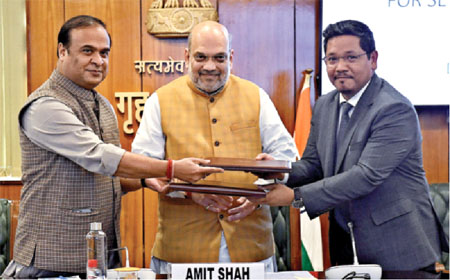Just a few months back when another series of violence erupted between Assam and Mizoram, there was a growing fear that it would be another derailment of the attained peace in the North East. But what happened on March 29, 2022 is nothing short of a silent revolution for peace. The five-decade long border dispute between Assam and Meghalaya got some mechanism towards resolution.
As per the agreement signed by Chief Ministers of Assam and Meghalaya, Himanta Biswa Sarma and Conrad K. Sangma respectively, in the presence of Union Home Minister Amit Shah, decided to end their five-decade-old border dispute in six of the 12 contested locations. As per the estimates, these six locations constitute 70 per cent of the border dispute.
Assam shares around 2,743 km boundary with Manipur, Mizoram, Tripura, Meghalaya, Arunachal Pradesh, Nagaland and West Bengal and is locked in some form of border disputes with Nagaland, Mizoram, Meghalaya and Arunachal Pradesh.To facilitate the process, the two States had formed three committees each in August 2021 to decode the complex boundary question. The two rounds of talks between Sarma and Sangma based on the recommendations of those committees led to the settlement of the dispute in a phased manner. Centre just facilitated the process. According to the joint final set of recommendations made by the committees, out of 36.79 sq km of disputed area taken up for settlement in the first phase, Assam will get full control of 18.51 sq km and Meghalaya 18.28 sq km.
North Eastern region, the real symbol of celebrating diversity in Bharat has been facing many such discords for decades. Despite many efforts, no long-lasting solutions have been found. What is the reason that Manipur has been blockade-free for five years; in Nagaland the NSCN-IM is being isolated and many militant groups are joining the peace process and with Assam most of the States are initiating the peace process? The answer lies in the approach.
The Narendra Modi-led Government at the Centre has ushered in a new era of connectivity and confidence-building in the region. The core issues of dismal infrastructure and misgovernance are being addressed with the constant efforts by the Centre-–holding the meetings of DONER Ministry in the region is one of such steps. The infrastructure connectivity with rest of Bharat has improved to a large extent. Even rail links are reaching the interior areas after seven decades. This is not only connecting Bharat geographically but also psychologically.
The cooperative federalism model and implementation of schemes across the regions, irrespective of any discrimination either on partisan or community basis, is another hallmark of the approach.
That is why when Assam Chief Minister Himanta Biswa Sarma said give and take can resolve the border disputes under the supervision of Centre; all Chief Ministers of the region endorsed it.
Most of the disputes are rooted in the colonial constructs of the regions and the way our States have been carved out based on identities. The approach endorsed and executed on the ground by the Rashtriya Swayamsevak Sangh to perpetuate the idea of One People, One Rashtra, One Sanskriti has slowly but firmly created an atmosphere for political and economic transition. Time and again, RSS has been articulating the position and possible solutions through various resolutions in the national-level meetings. The Narendra Modi Government is just giving them a shape through the State machinery.














Comments